Amin Beheshti
Macquarie University- Sydney-Australia
Modeling and Optimizing User Preferences in AI Copilots: A Comprehensive Survey and Taxonomy
May 28, 2025Abstract:AI copilots, context-aware, AI-powered systems designed to assist users in tasks such as software development and content creation, are becoming integral to modern workflows. As these systems grow in capability and adoption, personalization has emerged as a cornerstone for ensuring usability, trust, and productivity. Central to this personalization is preference optimization: the ability of AI copilots to detect, interpret, and align with individual user preferences. While personalization techniques are well-established in domains like recommender systems and dialogue agents, their adaptation to interactive, real-time systems like AI copilots remains fragmented and underexplored. This survey addresses this gap by synthesizing research on how user preferences are captured, modeled, and refined within the design of AI copilots. We introduce a unified definition of AI copilots and propose a phase-based taxonomy of preference optimization strategies, structured around pre-interaction, mid-interaction, and post-interaction stages. We analyze techniques for acquiring preference signals, modeling user intent, and integrating feedback loops, highlighting both established approaches and recent innovations. By bridging insights from AI personalization, human-AI collaboration, and large language model adaptation, this survey provides a structured foundation for designing adaptive, preference-aware AI copilots. It offers a holistic view of the available preference resources, how they can be leveraged, and which technical approaches are most suited to each stage of system design.
Ratas framework: A comprehensive genai-based approach to rubric-based marking of real-world textual exams
May 27, 2025Abstract:Automated answer grading is a critical challenge in educational technology, with the potential to streamline assessment processes, ensure grading consistency, and provide timely feedback to students. However, existing approaches are often constrained to specific exam formats, lack interpretability in score assignment, and struggle with real-world applicability across diverse subjects and assessment types. To address these limitations, we introduce RATAS (Rubric Automated Tree-based Answer Scoring), a novel framework that leverages state-of-the-art generative AI models for rubric-based grading of textual responses. RATAS is designed to support a wide range of grading rubrics, enable subject-agnostic evaluation, and generate structured, explainable rationales for assigned scores. We formalize the automatic grading task through a mathematical framework tailored to rubric-based assessment and present an architecture capable of handling complex, real-world exam structures. To rigorously evaluate our approach, we construct a unique, contextualized dataset derived from real-world project-based courses, encompassing diverse response formats and varying levels of complexity. Empirical results demonstrate that RATAS achieves high reliability and accuracy in automated grading while providing interpretable feedback that enhances transparency for both students and nstructors.
FlowDubber: Movie Dubbing with LLM-based Semantic-aware Learning and Flow Matching based Voice Enhancing
May 02, 2025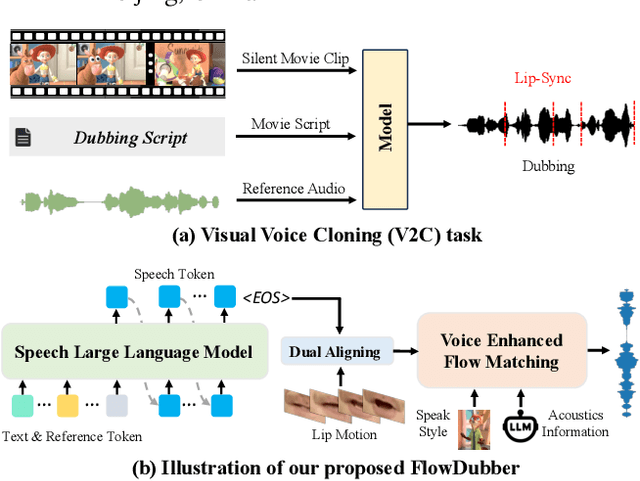

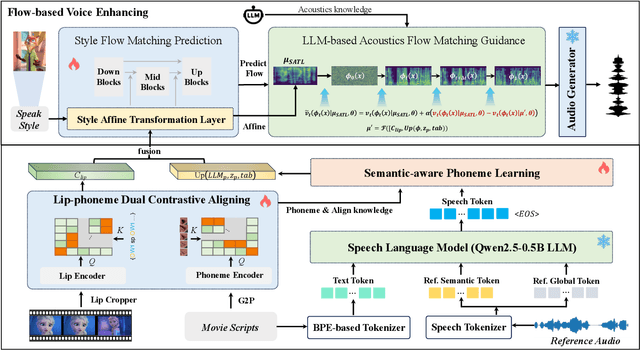

Abstract:Movie Dubbing aims to convert scripts into speeches that align with the given movie clip in both temporal and emotional aspects while preserving the vocal timbre of a given brief reference audio. Existing methods focus primarily on reducing the word error rate while ignoring the importance of lip-sync and acoustic quality. To address these issues, we propose a large language model (LLM) based flow matching architecture for dubbing, named FlowDubber, which achieves high-quality audio-visual sync and pronunciation by incorporating a large speech language model and dual contrastive aligning while achieving better acoustic quality via the proposed voice-enhanced flow matching than previous works. First, we introduce Qwen2.5 as the backbone of LLM to learn the in-context sequence from movie scripts and reference audio. Then, the proposed semantic-aware learning focuses on capturing LLM semantic knowledge at the phoneme level. Next, dual contrastive aligning (DCA) boosts mutual alignment with lip movement, reducing ambiguities where similar phonemes might be confused. Finally, the proposed Flow-based Voice Enhancing (FVE) improves acoustic quality in two aspects, which introduces an LLM-based acoustics flow matching guidance to strengthen clarity and uses affine style prior to enhance identity when recovering noise into mel-spectrograms via gradient vector field prediction. Extensive experiments demonstrate that our method outperforms several state-of-the-art methods on two primary benchmarks. The demos are available at {\href{https://galaxycong.github.io/LLM-Flow-Dubber/}{\textcolor{red}{https://galaxycong.github.io/LLM-Flow-Dubber/}}}.
SDVPT: Semantic-Driven Visual Prompt Tuning for Open-World Object Counting
Apr 24, 2025



Abstract:Open-world object counting leverages the robust text-image alignment of pre-trained vision-language models (VLMs) to enable counting of arbitrary categories in images specified by textual queries. However, widely adopted naive fine-tuning strategies concentrate exclusively on text-image consistency for categories contained in training, which leads to limited generalizability for unseen categories. In this work, we propose a plug-and-play Semantic-Driven Visual Prompt Tuning framework (SDVPT) that transfers knowledge from the training set to unseen categories with minimal overhead in parameters and inference time. First, we introduce a two-stage visual prompt learning strategy composed of Category-Specific Prompt Initialization (CSPI) and Topology-Guided Prompt Refinement (TGPR). The CSPI generates category-specific visual prompts, and then TGPR distills latent structural patterns from the VLM's text encoder to refine these prompts. During inference, we dynamically synthesize the visual prompts for unseen categories based on the semantic correlation between unseen and training categories, facilitating robust text-image alignment for unseen categories. Extensive experiments integrating SDVPT with all available open-world object counting models demonstrate its effectiveness and adaptability across three widely used datasets: FSC-147, CARPK, and PUCPR+.
ProgRoCC: A Progressive Approach to Rough Crowd Counting
Apr 18, 2025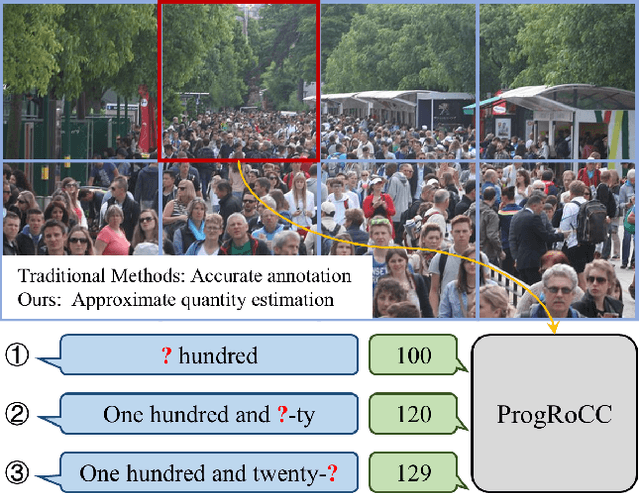
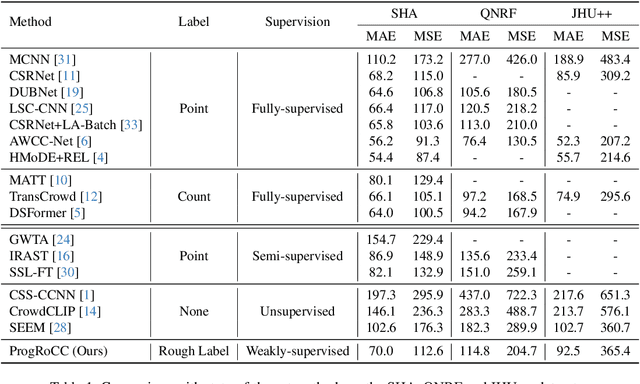
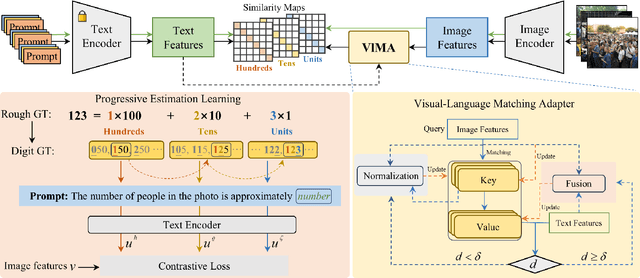

Abstract:As the number of individuals in a crowd grows, enumeration-based techniques become increasingly infeasible and their estimates increasingly unreliable. We propose instead an estimation-based version of the problem: we label Rough Crowd Counting that delivers better accuracy on the basis of training data that is easier to acquire. Rough crowd counting requires only rough annotations of the number of targets in an image, instead of the more traditional, and far more expensive, per-target annotations. We propose an approach to the rough crowd counting problem based on CLIP, termed ProgRoCC. Specifically, we introduce a progressive estimation learning strategy that determines the object count through a coarse-to-fine approach. This approach delivers answers quickly, outperforms the state-of-the-art in semi- and weakly-supervised crowd counting. In addition, we design a vision-language matching adapter that optimizes key-value pairs by mining effective matches of two modalities to refine the visual features, thereby improving the final performance. Extensive experimental results on three widely adopted crowd counting datasets demonstrate the effectiveness of our method.
The Devil is in the Distributions: Explicit Modeling of Scene Content is Key in Zero-Shot Video Captioning
Mar 31, 2025


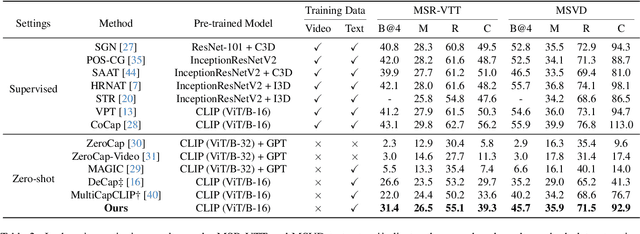
Abstract:Zero-shot video captioning requires that a model generate high-quality captions without human-annotated video-text pairs for training. State-of-the-art approaches to the problem leverage CLIP to extract visual-relevant textual prompts to guide language models in generating captions. These methods tend to focus on one key aspect of the scene and build a caption that ignores the rest of the visual input. To address this issue, and generate more accurate and complete captions, we propose a novel progressive multi-granularity textual prompting strategy for zero-shot video captioning. Our approach constructs three distinct memory banks, encompassing noun phrases, scene graphs of noun phrases, and entire sentences. Moreover, we introduce a category-aware retrieval mechanism that models the distribution of natural language surrounding the specific topics in question. Extensive experiments demonstrate the effectiveness of our method with 5.7%, 16.2%, and 3.4% improvements in terms of the main metric CIDEr on MSR-VTT, MSVD, and VATEX benchmarks compared to existing state-of-the-art.
VaxGuard: A Multi-Generator, Multi-Type, and Multi-Role Dataset for Detecting LLM-Generated Vaccine Misinformation
Mar 12, 2025Abstract:Recent advancements in Large Language Models (LLMs) have significantly improved text generation capabilities. However, they also present challenges, particularly in generating vaccine-related misinformation, which poses risks to public health. Despite research on human-authored misinformation, a notable gap remains in understanding how LLMs contribute to vaccine misinformation and how best to detect it. Existing benchmarks often overlook vaccine-specific misinformation and the diverse roles of misinformation spreaders. This paper introduces VaxGuard, a novel dataset designed to address these challenges. VaxGuard includes vaccine-related misinformation generated by multiple LLMs and provides a comprehensive framework for detecting misinformation across various roles. Our findings show that GPT-3.5 and GPT-4o consistently outperform other LLMs in detecting misinformation, especially when dealing with subtle or emotionally charged narratives. On the other hand, PHI3 and Mistral show lower performance, struggling with precision and recall in fear-driven contexts. Additionally, detection performance tends to decline as input text length increases, indicating the need for improved methods to handle larger content. These results highlight the importance of role-specific detection strategies and suggest that VaxGuard can serve as a key resource for improving the detection of LLM-generated vaccine misinformation.
VITAL: A New Dataset for Benchmarking Pluralistic Alignment in Healthcare
Feb 19, 2025

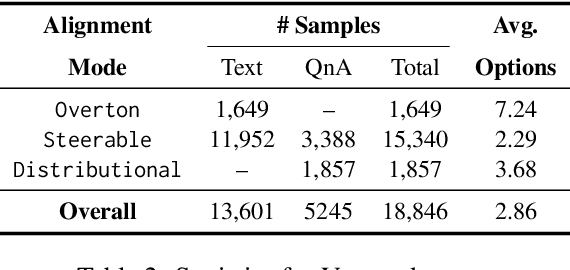

Abstract:Alignment techniques have become central to ensuring that Large Language Models (LLMs) generate outputs consistent with human values. However, existing alignment paradigms often model an averaged or monolithic preference, failing to account for the diversity of perspectives across cultures, demographics, and communities. This limitation is particularly critical in health-related scenarios, where plurality is essential due to the influence of culture, religion, personal values, and conflicting opinions. Despite progress in pluralistic alignment, no prior work has focused on health, likely due to the unavailability of publicly available datasets. To address this gap, we introduce VITAL, a new benchmark dataset comprising 13.1K value-laden situations and 5.4K multiple-choice questions focused on health, designed to assess and benchmark pluralistic alignment methodologies. Through extensive evaluation of eight LLMs of varying sizes, we demonstrate that existing pluralistic alignment techniques fall short in effectively accommodating diverse healthcare beliefs, underscoring the need for tailored AI alignment in specific domains. This work highlights the limitations of current approaches and lays the groundwork for developing health-specific alignment solutions.
FTA-FTL: A Fine-Tuned Aggregation Federated Transfer Learning Scheme for Lithology Microscopic Image Classification
Jan 06, 2025



Abstract:Lithology discrimination is a crucial activity in characterizing oil reservoirs, and processing lithology microscopic images is an essential technique for investigating fossils and minerals and geological assessment of shale oil exploration. In this way, Deep Learning (DL) technique is a powerful approach for building robust classifier models. However, there is still a considerable challenge to collect and produce a large dataset. Transfer-learning and data augmentation techniques have emerged as popular approaches to tackle this problem. Furthermore, due to different reasons, especially data privacy, individuals, organizations, and industry companies often are not willing to share their sensitive data and information. Federated Learning (FL) has emerged to train a highly accurate central model across multiple decentralized edge servers without transferring sensitive data, preserving sensitive data, and enhancing security. This study involves two phases; the first phase is to conduct Lithology microscopic image classification on a small dataset using transfer learning. In doing so, various pre-trained DL model architectures are comprehensively compared for the classification task. In the second phase, we formulated the classification task to a Federated Transfer Learning (FTL) scheme and proposed a Fine-Tuned Aggregation strategy for Federated Learning (FTA-FTL). In order to perform a comprehensive experimental study, several metrics such as accuracy, f1 score, precision, specificity, sensitivity (recall), and confusion matrix are taken into account. The results are in excellent agreement and confirm the efficiency of the proposed scheme, and show that the proposed FTA-FTL algorithm is capable enough to achieve approximately the same results obtained by the centralized implementation for Lithology microscopic images classification task.
Adapter-Enhanced Semantic Prompting for Continual Learning
Dec 15, 2024



Abstract:Continual learning (CL) enables models to adapt to evolving data streams. A major challenge of CL is catastrophic forgetting, where new knowledge will overwrite previously acquired knowledge. Traditional methods usually retain the past data for replay or add additional branches in the model to learn new knowledge, which has high memory requirements. In this paper, we propose a novel lightweight CL framework, Adapter-Enhanced Semantic Prompting (AESP), which integrates prompt tuning and adapter techniques. Specifically, we design semantic-guided prompts to enhance the generalization ability of visual features and utilize adapters to efficiently fuse the semantic information, aiming to learn more adaptive features for the continual learning task. Furthermore, to choose the right task prompt for feature adaptation, we have developed a novel matching mechanism for prompt selection. Extensive experiments on three CL datasets demonstrate that our approach achieves favorable performance across multiple metrics, showing its potential for advancing CL.
 Add to Chrome
Add to Chrome Add to Firefox
Add to Firefox Add to Edge
Add to Edge